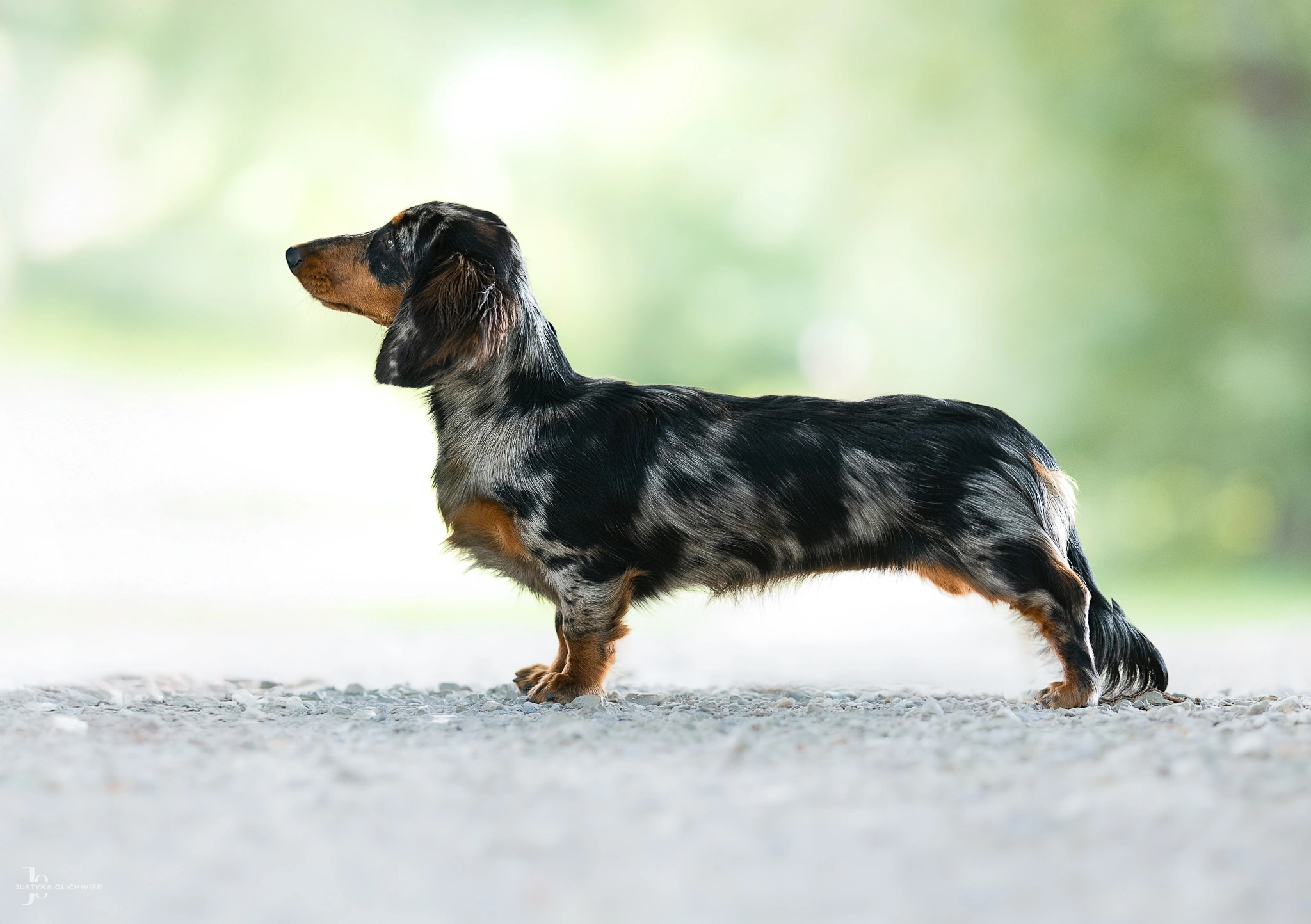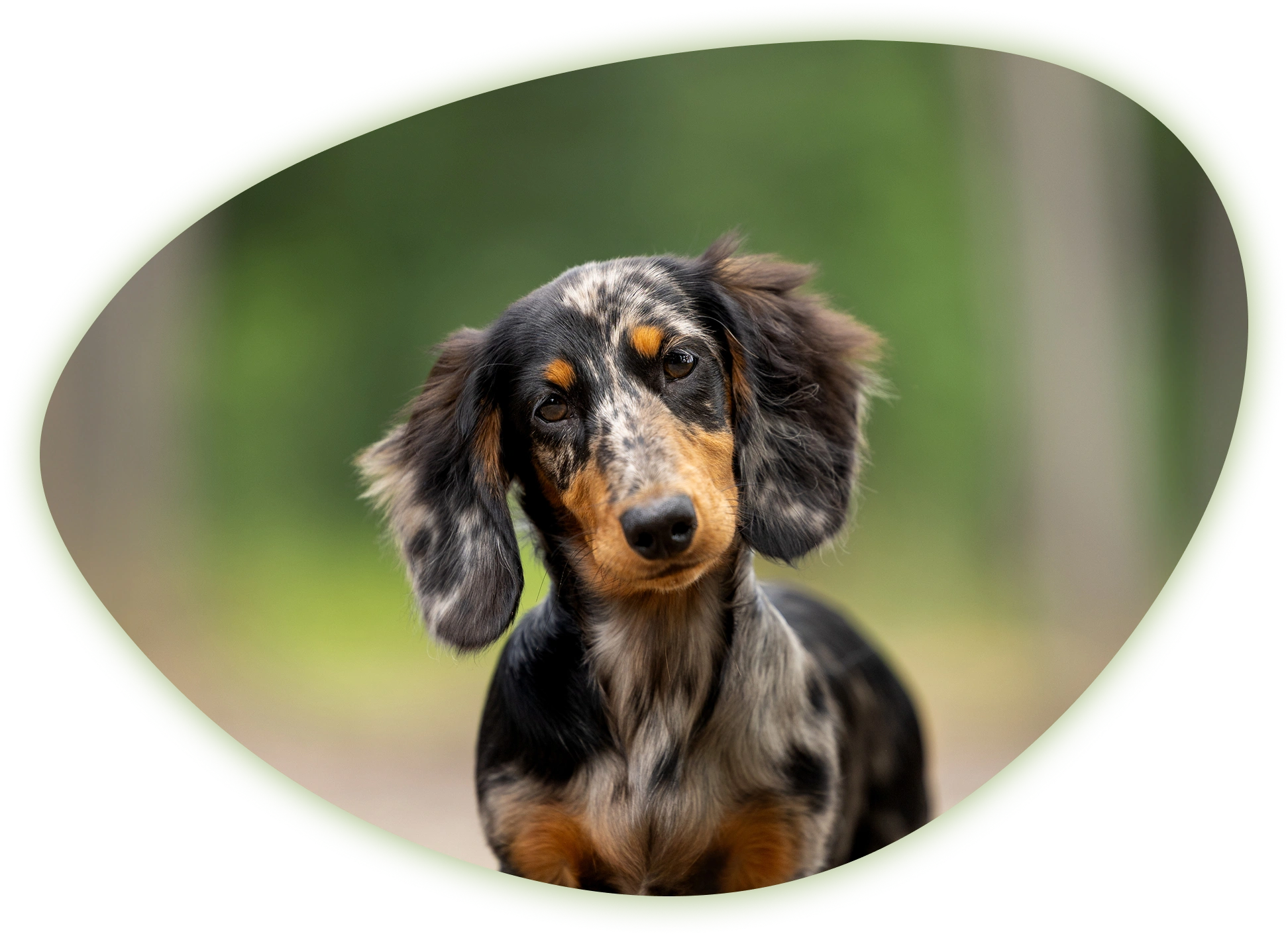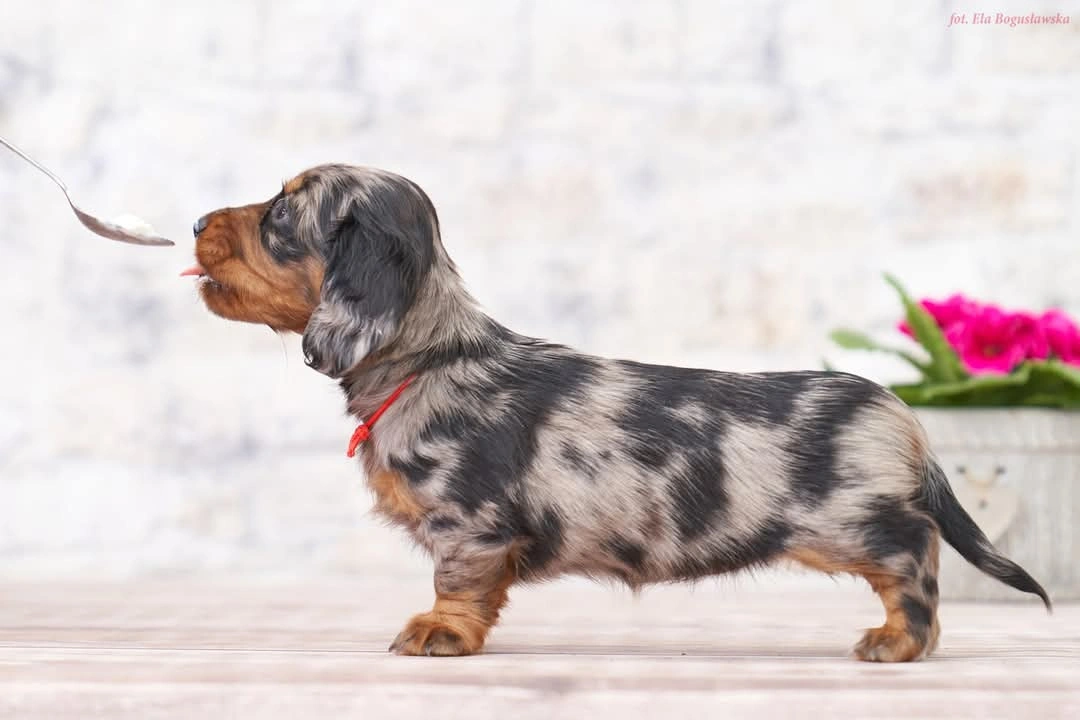
The miniature and rabbit long-haired Dachshund is one of the gentlest and most elegant varieties of this popular breed. It combines the characteristic Dachshund structure (a long torso and short legs) with a beautiful, flowing coat.
It’s walking elegance… on a very low suspension.
A Light-Hearted Look at the BreedThe Floor Gentleman
If you’ve ever dreamed of a dog that looks like it’s been stretched by the ears and sprinkled with a silky wig, you’ve found him.
The long-haired Dachshund proudly proves that elegance doesn’t require height.
Appearance: Short Body, Long Hair, Big EgoBody: This dog has an unbelievable length-to-height ratio. Think “a long candy bar on four sticks.” It always looks like it’s just emerged from a tunnel.
Size (Miniature): Weighs about as much as a good bag of sweets, with a chest circumference like a solid bagel. Despite the small size, it firmly believes a fierce wolf lies within.
Coat: This is its crown. The hair is long, flowing, and silky. The most stunning “feathers” (fringes) adorn the ears and tail, giving the impression the dog is constantly starring in a slow-motion shampoo commercial.
Personality: The Stubborn Drama Actor The long-haired Dachshund is a mix of aristocrat and determined miner.
Stubbornness (main trait): Incredibly intelligent, but uses that intelligence mainly to negotiate rules and find loopholes in your system. If you let it, it will take charge of the household. Training requires brick-hard consistency and saintly patience.
Attachment: A classic velcro dog. It hates being alone. If you leave, expect to find it exactly where you left it — on the couch, pretending to die of longing.
Hunting Instinct: Despite its silky coat and love of comfort, it has the soul of a hunter. Sniffing, tracking, and digging are its missions in life. No garden is safe. No mole is safe. Even the laundry pile isn’t safe.
Gentleness: Of all Dachshund varieties, this one is the most affectionate and sweet-natured. You could call it the Cuddler Dachshund. It loves to snuggle and will sneak under any duvet — perhaps because it reminds them of a warm, dark burrow.
Feeding: A small dog with a T-Rex appetite. Prone to weight gain (which is dangerous for its back). It will look into your eyes while you eat with such guilt-inducing intensity that you’ll feel like you’ve been starving it for weeks. Don’t give in!
Sound: An excellent watchdog with a bark completely disproportionate to its size. It sounds like a Rottweiler is behind the door, not a 5 kg gentleman.
In summary: The long-haired Dachshund is a small, luxurious, and stubborn companion who will bring endless love and personality into your life.
Are you ready for a dog that believes he’s bigger, more important, and far more glamorous than you?
Dachshunds are generally a healthy, hardy, and long-lived breed. However, due to their distinctive body shape — long back and short legs — they are genetically predisposed to certain spinal conditions (a trait called chondrodystrophy), which increases the risk of serious back problems.
The most common health issues include:
- Intervertebral Disc Disease (IVDD)
- Progressive Retinal Atrophy (PRA)
- Cataracts
- Ear infections
- Tartar build-up and dental disease
Below, you’ll find more detailed information about the most common health issues affecting this breed.

This is the most common spinal condition in chondrodystrophic dogs. In simple terms, it involves the degeneration of the intervertebral discs, which act as shock absorbers between the vertebrae.
Mechanism: Over time, in predisposed dogs, the nucleus pulposus (the soft inner part of the disc) loses its elasticity and hardens, while the fibrous ring surrounding it weakens and may rupture. This leads to the disc material protruding or herniating into the spinal canal, where it puts pressure on the spinal cord.
Symptoms:
Symptoms can appear suddenly and are often very painful. They may include:
- Pain (the dog may avoid being touched or whimper),
- Stiffness in movement,
- Lameness or weakness in the hind legs,
- Difficulty standing up or climbing stairs,
In severe cases: paralysis and loss of bladder or bowel control.
Treatment: The treatment depends on the severity of the condition and can include conservative management (anti-inflammatory medication and crate rest) or surgery to relieve pressure on the spinal cord.
Dachshunds, especially long-haired varieties with lighter coats, may be predisposed to certain eye conditions:
Progressive Retinal Atrophy (PRA): A hereditary disease that leads to blindness.
Cataracts: Clouding of the lens.
Tip: Regular ophthalmologic check-ups are recommended for older dogs.
The long, floppy ears of long-haired Dachshunds create a warm and poorly ventilated environment, which can trap moisture and lead to ear infections (otitis externa), often caused by yeast or bacteria.
Tip: Regular ear checks and cleaning are essential.
Small breeds, including miniature Dachshunds, are particularly prone to tartar build-up and periodontal disease, which can lead to tooth loss and more serious infections.
Tip: Daily tooth brushing or regular professional ultrasonic cleaning is crucial.

Grooming a long-haired Dachshund requires regular care to keep their beautiful coat shiny and healthy, and to ensure the dog feels comfortable.
Frequency: A long-haired Dachshund should be brushed at least once a week. During shedding seasons or if the dog spends a lot of time outdoors, daily brushing may be necessary.
Purpose: Regular brushing prevents tangles and matting of the undercoat — which is crucial because long-haired Dachshunds have delicate skin prone to irritation. Brushing also helps remove dead hair.
Tools: A suitable brush (e.g., a bristle or pin brush with rounded tips) and a comb for gently working through any tangles are ideal.
Frequency: Baths are usually needed every 2–3 months or when the dog is particularly dirty. Overbathing can dry out the skin and coat.
Products: Use shampoos and conditioners designed for long-haired dogs. These help with detangling and moisturizing the coat and skin. Products with nourishing oils (e.g., mink or almond oil) work especially well.
Suszenie: Po kąpieli sierść powinna być dokładnie wysuszona – najlepiej suszarką na średniej temperaturze. Pozostawienie wilgotnej sierści może prowadzić do przeziębienia i problemów skórnych.
Ears: Due to their long, floppy ears, Dachshunds are prone to ear infections. Check and clean the ears regularly using special ear-cleaning solutions. Trim excess hair around the ears to improve airflow.
Eyes: Check the eyes regularly and clean them if necessary.
Teeth: Maintain good oral hygiene by brushing your dog’s teeth with dog toothpaste to prevent tartar build-up.
Nails: Trim the nails regularly if they don’t wear down naturally.
Paws: Trim the hair between the paw pads.
Coat: The hair on the tail, chest, and belly is the longest and requires extra attention when brushing.
Clothing: Because Dachshunds are sensitive to cold and damp weather, protective coats or bodysuits are useful during chilly, rainy walks — and they help keep the dog clean too.
If you’re not confident with grooming at home, consider regular visits to a professional groomer who can take care of your Dachshund’s coat and overall hygiene.